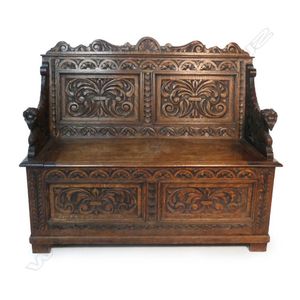Victorian Oak Hall Seat with Mythical Beast Arms
A Victorian oak hall seat, the back, sides and front entirely carved with scrolls, shells and floral motifs, the arms carved with mythical beasts to the front, lift up seat for storage. 123 x 48 x 103 cm.
You must be a subscriber, and be logged in to view price and dealer details.
Subscribe Now to view actual auction price for this item
When you subscribe, you have the option of setting the currency in which to display prices to $Au, $US, $NZ or Stg.
This item has been sold, and the description, image and price are for reference purposes only.
- Victorian Period - The Victorian period of furniture and decorative arts design covers the reign of Queen Victoria from 1837 to 1901. There was not one dominant style of furniture in the Victorian period. Designers used and modified many historical styles such as Gothic, Tudor, Elizabethan, English Rococo, Neoclassical and others, although use of some styles, such as English Rococo and Gothic tended to dominate the furniture manufacture of the period.
The Victorian period was preceded by the Regency and William IV periods, and followed by the Edwardian period, named for Edward VII (1841 ? 1910) who was King of the United Kingdom and the British Dominions and Emperor of India for the brief period from 1901 until his death in 1910. - Scrolls - Serpentine-shaped forms, used in cabinet construction and decoration for centuries. The scroll appears in legs, feet, as carving in chair brackets, chair rails and arms. The deeper and more spontaneous the carving is, the earlier the piece is likely to be. The Regency or 'Thomas Hope' scroll, used on pediments and sideboard backs, consists of two scrolls on the horizontal plane, placed back to back in a mirror image, and sometimes decorated with a variety of carved and/or applied ornament, such as shells, foliate and other motifs. Chippendale-style furniture is often distinguished by two corresponding scrolls in the form of a 'C' in the upper splat or where chair legs join the seat rail.
- Oak - Native to Europe and England, oak has been used for joinery, furniture and building since the beginning of the medieval civilisation. It is a pale yellow in colour when freshly cut and darkens with age to a mid brown colour.
Oak as a furniture timber was superceded by walnut in the 17th century, and in the 18th century by mahogany,
Semi-fossilised bog oak is black in colour, and is found in peat bogs where the trees have fallen and been preserved from decay by the bog. It is used for jewellery and small carved trinkets.
Pollard oak is taken from an oak that has been regularly pollarded, that is the upper branches have been removed at the top of the trunk, result that new branches would appear, and over time the top would become ball-like. . When harvested and sawn, the timber displays a continuous surface of knotty circles. The timber was scarce and expensive and was used in more expensive pieces of furniture in the Regency and Victorian periods.
This item has been included into following indexes:
